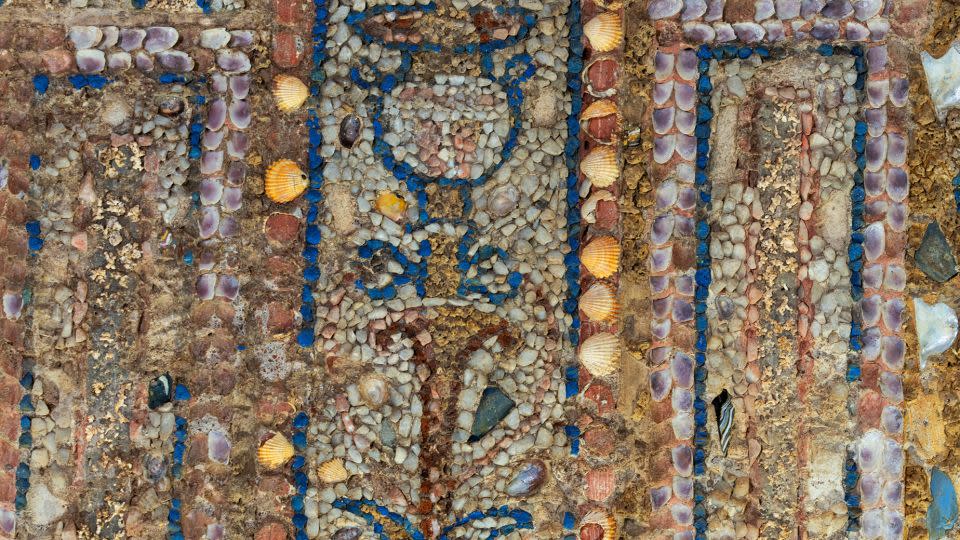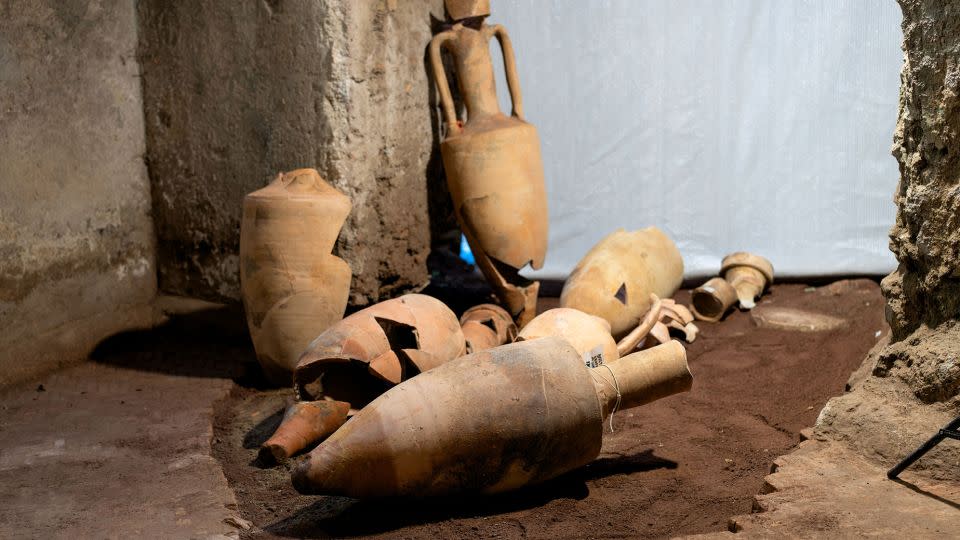The treasure was uncovered last week when archaeologists, during a five-year excavation on the edge of Rome’s Palatine Hill, discovered a lavish banqueting room from the 1st or 2nd century BC that contained a large, intact and brightly colored wall mosaic.
The work, estimated to be approximately 2,300 years old, is part of a larger aristocratic mansion located near the Roman Forum and whose excavations have been ongoing since 2018.
The mosaic scene, which is almost five meters long (16.4 ft) and includes depictions of vines, lotus leaves, tridents, trumpets, helmets and mythological sea creatures, was painstakingly created using mother-of-pearl, seashells, corals, precious glass shards and marble particles. . The piece is framed with multicolored crystals, spongy travertine, and exotic, ancient Egyptian blue tiles.
Archaeologist Alfonsina Russo, head of the Colosseum Archaeological Park, said what made this discovery “unique” was not only the incredible preservation of the mosaic, but also its decoration, which included celebratory scenes of naval and land battles that were probably financed. – and it was won by an extremely wealthy aristocratic patron who commemorates the victories on his walls.

The complexity of the mosaic’s depictions of victory surprised the team working on the project. They show a coastal walled town with watchtowers and loggias, perched on a cliff designed with travertine boulders, which Russo said could be an ideal or real-life location. Alongside depictions of legendary sea monsters devouring enemy fleets, there are also scenes of sailing ships with raised sails.
Archaeologists are trying to determine whether the delicate and then-expensive coral branches used in the exhibit came from the Mediterranean or the Red Sea (the closest and most common oceans used by the Romans to extract material). The team believes that a rare bluish glass paste featured in the design also likely came from the ancient Egyptian city of Alexandria.
“Measuring 25 square meters (270 square feet), this banquet hall is just one area within a ‘domus’ (the Latin word for house) spread over several floors,” Russo said in an interview with CNN. “In ancient times, when powerful noble families lived on the Palatine Hill, it was customary to use rich decorative elements as symbols of showing wealth and high social status.”
The room considered a “jewel” by Russo was an open-air banquet hall overlooking the garden, probably used to entertain guests during the summer months.
Such an elaborate area must also have been used to impress guests with water games, which were very popular among the nobility at the time. “We found lead pipes embedded in decorated walls, constructed to carry water inside basins or to flow fountains to create water games,” Russo said.


Marco Rossi, professor of Roman antiquities and head of the mosaic laboratory at the Università degli Studi di Roma Tre in Rome, pointed out that summer banquet rooms were not only places where hosts and guests went to relax, but were also used as displays by the manor owner. of their wealth and position.
Rossi said of the work: “Mosaics are usually found on the floors, but this runs the entire front wall and is incredibly well preserved.” “It was not damaged by the weight of the debris, as some of the mosaics on the ground were, and although it is delicate, it has not broken down over the centuries.”
Rossi added that it is extremely rare to find an entire wall mosaic, especially because these pieces are more delicate than those on the floor, which is designed to be walked on and withstand pressure.
Scientists believe that the location of the large house also helped preserve the wall. Located on the slopes of Rome’s famous Palatine Hill, and covered with mud and soil as the land moved over the centuries, the structure and the treasures inside were protected from air and light by layers of ground.
While this new discovery still has many secrets to uncover — such as why the property was abandoned and how long ago — Russo believes there’s one mystery that archaeologists could perhaps solve: The identity of its owner, possibly a Roman senator.
“This person was so rich that he could afford to import such valuable elements from all over the empire to decorate this mansion,” Russo said. “So far we have found nothing to shed light on their identity, but we believe further investigation may enable us to locate the noble family.”
Russo and his team aim to open the space to the public in early January. “We will continue to excavate other layers and areas of this evocative place (to try to discover more),” he said. “This is truly an incredible display of Roman luxury.”
For more CNN news and newsletters, create an account at CNN.com